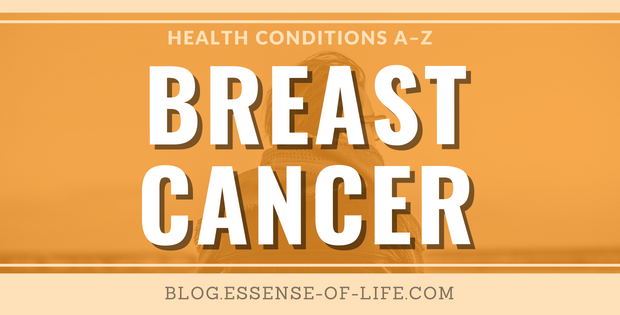Breast Cancer: What To Do If You Have Been Diagnosed With Breast Cancer

Diagnosed With Breast Cancer?
Breast Cancer is the second most common cancer in women and affects 1 in 8 women or 12.4% of women in the US with an estimated 266,120 new cases expected to be diagnosed in 2018. In most cases, breast cancer is discovered only after symptoms appear but unfortunately many women with breast cancer have no symptoms at all. There are several tests and screenings available to look for and diagnose breast cancer.
Breast Cancer Causes
Breast cancer occurs when normal cells within the breast undergo a change on a cellular level which causes them to begin functioning abnormally and begin spreading and taking over surrounding healthy tissue. There are two types of tumors found in the breast.
BENIGN
A nonmalignant tumor is a tumor that is not considered cancerous and that does not invade the surrounding tissue.
MALIGNANT
Malignant tumors are tumors that are cancerous and aggressive because they invade and damage surrounding tissue.
Women with certain risk factors are more likely to be diagnosed with breast cancer. Some of the risk factors are unavoidable but some like exercise habits, unhealthy diet, smoking or alcohol consumption can be avoided.
Breast Cancer Risk Factors
AGE
The majority of aggressive, invasive breast cancers occur in women over the age of 55.
FAMILY HISTORY
A family history of breast cancer has been shown to dramatically increase the chances of diagnosis. If an immediate family member has been diagnosed with breast cancer, you have a much higher risk of being diagnosed with breast cancer in the future.
GENETICS
Caucasian women are more often diagnosed with breast cancer than any other race. Early menstruation (before age 12) and or late menopause (after 55) also increase your risk for breast cancer as does having your first child at an older age, or never having given birth. Mutations in certain genes (BRCA1 and BRCA2) can indicate an increase in your risk for breast cancer. Studies have also found that having dense breast tissue can increase your risk for breast cancer.
EXTERNAL EXPOSURE
Exposure to radiation therapies before the age of 30 and long-term hormone therapy are both external factors that can increase the risk of a breast cancer diagnosis.
DIET
Body weight and physical activity level have been showed to have a direct relationship with overall hormonal health of women. A diet high in saturated fat, processed foods and lacking fruits and vegetables can increase your risk for many diseases, including breast cancer. Being overweight or obese also increase your risk. This is why healthy diet and lifestyle changes can be very beneficial in decreasing your risks.
Breast Cancer Symptoms
Watch for these early breast cancer symptoms. If you experience any of the common early symptoms, speak with your doctor right away.
COMMON EARLY SYMPTOMS
— Changes in size, shape or appearance of breast (ie. newly inverted nipple)
— Lump or thickening area on breast
— Redness, pain, blister or irritation on surface of breast
— Clear or blood tinged discharge from nipple
Breast Cancer Prognosis
Cancer is usually labeled in stages ranging from I to IV with stage IV being reserved for the most advanced cases. The prognosis for patients diagnosed with breast cancer varies greatly based on the stage that a woman is diagnosed with at the time of discovery of the cancer. An overall survival rate shows the percentage of people who are alive after a certain period of time after a cancer diagnosis. Cancer survival rates are based on survival beyond a 5 year time frame.
STAGE I
Localized: The cancer cells have not spread beyond the organ where they began to grow. The 5 year survival rate with this stage or breast cancer is 99%.
STAGE II
Regionalized: The cancer cells have spread beyond the area where they began (into nearby lymph nodes, for example), but this spread is limited. The 5 year survival rate with this stage is about 85%.
STAGE III – IV
Distant: The cancer cells have spread to other parts of the body (metastasized). The survival rate with this stage of cancer is only 27%.
Breast Cancer Treatments
If you have been diagnosed with breast cancer, you and your doctor should fully discuss the benefits and risks associated with each option.
SURGERY
Surgery is used to remove cancer tumors, whether in whole or in part. There are two main surgery options available:
— Breast conserving surgery, in which only the part of the breast containing cancerous cells is removed.
— Mastectomy which involves full removal of all breast tissue and sometimes surrounding tissue (margins) and lymph nodes.
RADIATION
Radiation therapy is used to shrink tumors and can be used with or without surgery. The two main choices for radiation treatment are:
— Internal radiation, in which a radioactive “seed” is implanted into the tissue to release radiation to the surrounding tissue over time.
— External Radiation, in which a machine administers the radiation treatment and several treatments may be needed over the course of 5-6 weeks.
HORMONE THERAPY
In some cases, the type of cancer in the breast may be affected by hormones in the blood. If breast cancer cells are affected by estrogen, then an estrogen-reducing hormone therapy may be used. Hormone therapy is also used after surgery to prevent cancer from recurring.
CHEMOTHERAPY
Oral or IV chemotherapy is used if a tumor is too large to remove or needs to be decreased in size before surgery. It is often recommended after surgery or radiation to target any cancer cells that might have been missed during treatment. Chemotherapy is also used for instances where cancer has spread (metastasized) to other areas.
TARGETED THERAPY
Targeted therapy involves drugs that contain specific immune system proteins. This is a newer field of research.
ALTERNATIVE TREATMENTS
There are many alternative breast cancer treatments available as well. Many people opt to use some kind of alternative treatment alongside the traditional treatment they are receiving.
Diet and Breast Cancer
If you have been diagnosed with breast cancer, diet is the #1 most important thing you can do to improve your overall health. The goal is to slow breast cancer growth while improving immune system function in order to help give your body a fighting chance. A healthy immune system is better able to help repair and rebuild damaged cells.
Unlike healthy cells which have a very efficient aerobic (with oxygen) metabolism, breast cancer cells use anaerobic (without oxygen) metabolism. Anaerobic metabolism relies on the fermentation of glucose (sugar) for fuel, which is a very inefficient process. Anaerobic metabolism not only creates an energy drain on the body, but also creates an excess of acidic lactic acid as a waste product.
Breast cancer creates a very acidic environment in the body. Through diet, you can increase alkaline intake to neutralize these excess acidic wastes. Excess acid in the body creates a range of side effects including joint pain, muscle pain, and tissue damage. Therefore, alkalizing is especially relevant to breast cancer treatment.
Alkaline Diet for Breast Cancer
The goal of an alkaline diet, which focuses on eating 60-80% alkaline-forming foods such as fruits and vegetables, is to reduce the overall acid load on the body. An alkaline diet can help to combat lactic acid issues associated with cancer while also helping eliminate the harmful toxins and synthetic hormones common in the average American diet.
FOODS TO EAT:
— Fresh Organic Fruits
— Fresh Organic Vegetables
— Lean Organic Meat
— Plant Based Protein
FOODS TO LIMIT:
— Dairy Products
— Wheat and Glutenous Grains
— Coffee and Tea
— Alcohol
— Polyunsaturated Oils
FOODS TO AVOID:
— Refined Sugars
— Artificial Sweeteners
— Processed Foods
— MSG
— Soy
— Pork
— Hydrogenated Fats
Immune System Boosting with pH Therapy
Dr. Otto Warburg received the Nobel prize in 1931 for the discovery that unlike all other cells in the human body, cancer cells do not breathe oxygen. Normal healthy cells are very efficient at generating energy through aerobic (oxygen) metabolism. Cancer cells, on the other hand, are anaerobic (without oxygen) and do not need oxygen to survive. It turns out that cancer cells actually cannot survive in the presence of high levels of oxygen. One appealing line of treatment therefore is to increase the body’s levels of oxygen.
High pH Therapy focuses on using a combination of an alkaline diet and alkaline minerals to reduce acid loads, increase oxygen content, and support the immune system, which is the body’s natural defense system. A healthy immune system is better able to help repair and rebuild damaged cells.
Improving Breast Cancer Outcomes
Most of all, when it comes to breast cancer treatments, it is good to know that there are many options available. A combination of traditional cancer treatment, diet change, and complementary alternative cancer therapies can increase quality of life and improve overall outcome.
SOURCES
https://seer.cancer.gov/statfacts/html/breast.html
https://www.breastcancer.org/symptoms
https://www.cancer.org/cancer/breast-cancer.html
https://www.cancer.gov/types/breast
RELATED TOPICS
Top 5 Alternative Cancer Treatments
Do You or Someone You Know Have Cancer? Looking for Options?
This article is copyright ©2018 Essense of Life, LLC. All rights reserved. Do not copy without permission.
The information contained herein is not medical advice and is not intended to replace the advice or attention of your personal physician or other health care professionals. This information is not intended as a prescription for treatment nor is it intended to diagnose, treat, cure or prevent any disease.

Facebook Comments